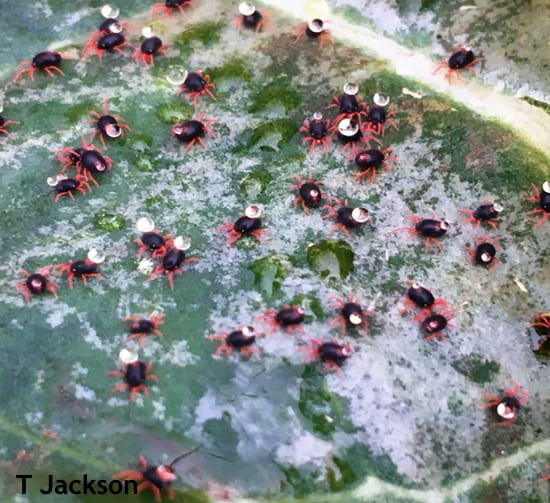Apr 5, 2020Red-legged winter mites spread in high tunnel leafy greens
The red-legged winter mite, Penthaleus dorsalis, has been found in more high tunnels growing leafy greens this past winter for the third year in a row. Most of the reports I have gotten from high tunnels are from the Eastern seaboard, but now I am receiving reports from locations further inland, such as Baltimore and Howard counties.
Red-legged winter mites have dark purple/black bodies and bright red legs (Fig. 1). They thrive in what we would normally consider conditions too cold for an arthropod to cause problems. This mite is cold adjusted and cannot stand hot dry soil conditions and will die as summer heat approaches. Eggs are laid in late spring and over-summer in the soil.
These are stress resistant eggs (i.e., they withstand drying and heat as well as synthetic chemical applications). In the fall they will begin to hatch and mites will be active throughout the fall and winter inside a high tunnel with crops. Damage appears as “silvering” or “whitening” of the attacked foliage (Fig. 2). Mites are most damaging to newly emerging crops, greatly reducing seedling survival and development.
Red-legged winter mites are difficult to control even when using synthetic chemicals. Foliar sprays of pyrethroids (check label for the particular crops that are labeled as this will vary greatly) or Pyrethrum +Neem or Entrust (spinosad) will reduce feeding, but if mite populations are high it will be difficult to eliminate the damage. Applications should start as soon as damage is noticed before mites have a chance to build their population. Foliage should be thoroughly covered with spray material as should soil around the base of plants.
Cultural controls involve using high levels of heat such as clear plastic mulch that is used to heat the soil and kill mites and, if used in the summer, even their eggs. Steam heat used to control nematodes and soil pathogens can be used to greatly reduce mite numbers before next fall planting. Many cultivations during the summer can significantly decrease the number of over-summering eggs that survive.
If any growers of high tunnel leafy greens from this past winter could send me an email ([email protected]) telling me if they have seen the mites and how much if any damage they caused it would be greatly appreciated.
Figure 2. Red legged winter mite damage to spinach.
– Jerry Brust, IPM Vegetable Specialist, University of Maryland
At top: Figure 1. Red legged winter mites with drops of water on them.
















